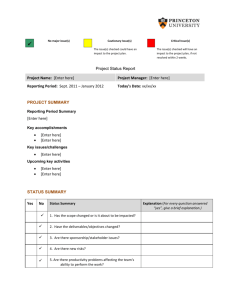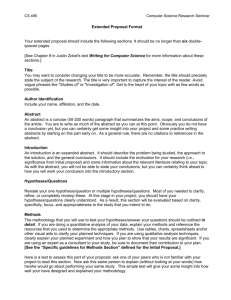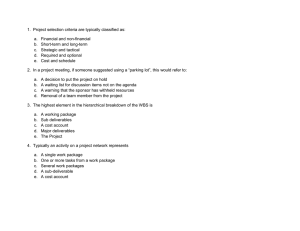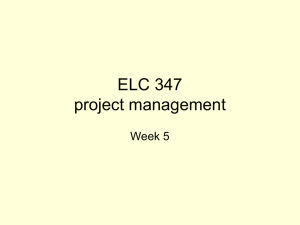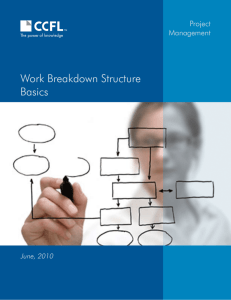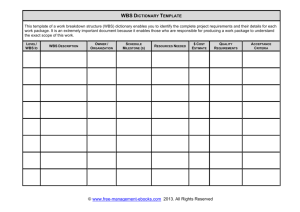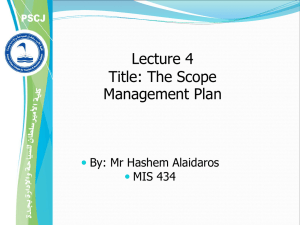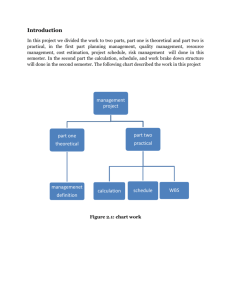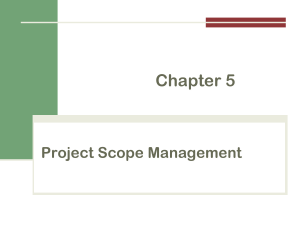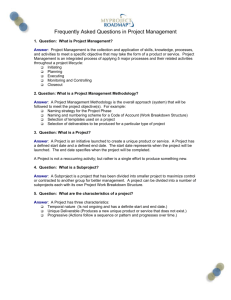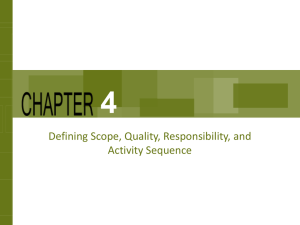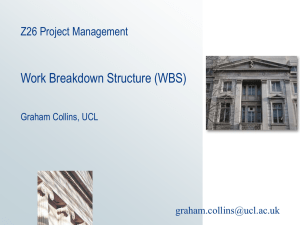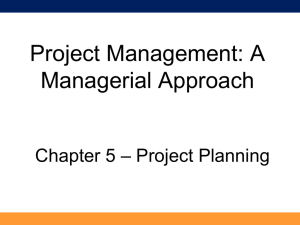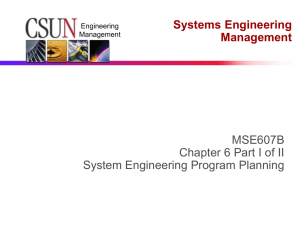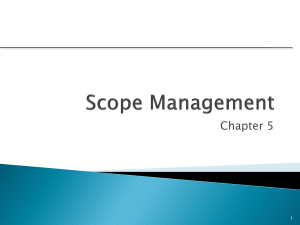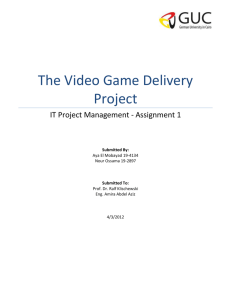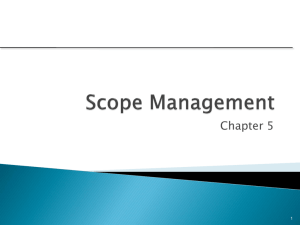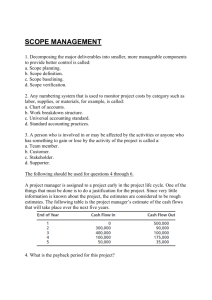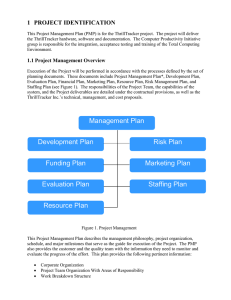Project Schedule 项目进度表
advertisement
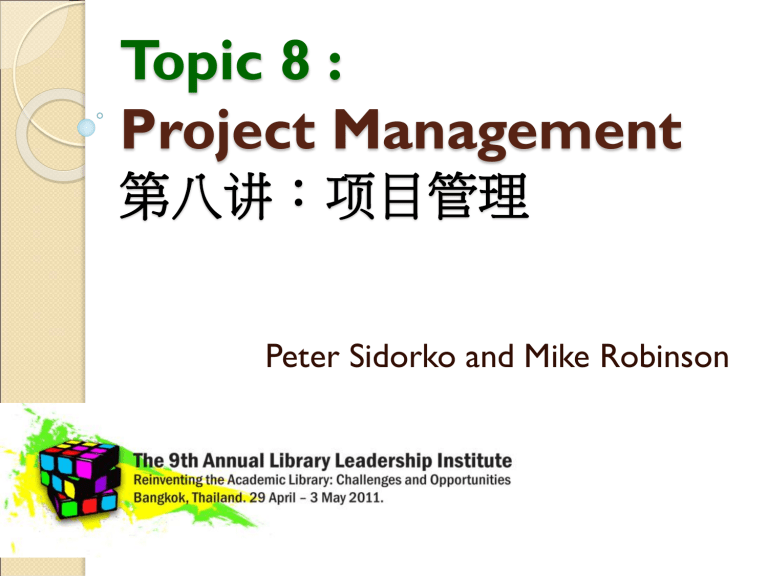
Topic 8 : Project Management 第八讲:项目管理 Peter Sidorko and Mike Robinson Goals 目标 Provide an overview of Project Management 概述项目管理 Become familiar with key project deliverables 熟悉主要的项 目交付物 Practice developing a project schedule 练习制订项目 进度表 2 Objectives of Project Management 项目管理的目标 Better skills in managing projects 提高项目管理技巧 Develop realistic timelines 制定实际进程 Manage expectations 管理可预测的事情 Avoid problems with mismanaged projects Better delegation of responsibilities 避免因项目管理不当 而产生问题 更有效地授予责任 Project characteristics 项目特色 A task of finite duration Not a permanent activity Produces a new product, service or other result. 有限时间内的任务 并非永久活动 制造新产品,新服务或 其它成果. Project Definition 项目的定义 Defined beginning and end 设定起始及终结 One time effort 一次性工作 Produces an identifiable, measurable, unique product, service, result 产出一项可识别、可 量度、独一无二的产 品、服务或结果 Project team works together for length of project 项目进行阶段,全组 并坚作战。 5 Project Triggers 项目触发因素 Market driven needs 市场需要 Organizational needs 组织需要 Customer needs 顾客需要 Technological advances 科技进展 Legal requirements 法律要求 6 Benefits of Project Management 项目管理的好处 Improves ability to deliver project on-time, on-budget 提升准时而不失预算地 交付项目结果的能力 Provides a methodology to follow 提供一个可遵循的方法 Ensures common understanding of project needs & deliverables 确保对项目的需求及交 付物有所共识 提高生产力 确保对项目及产品的需 要有足够的沟通 提升质量 管理风险 Improves productivity Ensures communication of project and product needs Improves quality Manages risk 7 Benefits of Project Management 项目管理的好处 Better skills in managing projects 提高项目管理技巧 Develop realistic timelines 建立实际时间表 Manage expectations 管理期望 Avoid problems with mismanaged projects 避免因项目管理不 当而产生问题 Better delegation of responsibilities 更有效地授予责任 Benefits of Project Management 项目管理的好处 Applies structured techniques to facilitate a more efficient approach to planning an executing a project 运用建构技巧以助 采取更有效的方法 去计划和执行项目 Applies organizational structure 运用组织架构 A more analytic approach 更着重分析的方法 Key Project Deliverables 主要项目交付物 1. Project Charter 1. 项目章程 2. Scope Statement 2. 范围陈述 3. Change Control 3. 转变控制 4. Project Schedule 4. 项目进度表 5. Status Report 5. 状况报告 6. Communication Plan 6. 沟通计划 7. Risk Analysis & Plan 7. 风险分析及计划 10 Developing the Project Schedule 编制项目进度表 Step 1 : Develop a WBS (Work Breakdown Structure) Step 2 : Define the activities Step 3 : Develop a milestone list Step 4 : Put the activities in order Step 5 : Estimate duration and work Step 6 : Assign people to activities 步骤一 :编制工作分解结构 步骤二 :設定各项活动 步骤三 :列出项目里程碑 步骤四 :将各项活动排序 步骤五:估计历时及工作 步骤六 :分派人手予各项工作 11 Project Schedule 项目进度表 Step 1 : Develop a Work Breakdown Structure 步骤一 :编制工作分解结构 Divides work into smaller tasks that can be defined, estimated, and tracked 细分工作成明确、可估计及 跟进的任务 Decompose tasks until each has known qualities: 分解各任务直至其特质可明 确了解 ◦ Each task has a deliverable ◦ Can be assigned to a person ◦ 可分派给某人员 ◦ Start and end dates can be identified ◦ 起始及结束日可订明 ◦ Duration is reasonable (two weeks or less) Work not defined in WBS is outside project scope ◦ 所有任务均有一交付物 ◦ 持续时间合理 ( ≤ 2星期) 没有設定在工作分解结构内 的工作均不属项目范围 12 Work Breakdown Structure for the recruitment of a new person to fill a vacant post http://www.spottydog.u-net.com/guides/faq/faq.html Project Schedule 项目进度表 Step 2 : Define the Activities 步骤二 :确定各项活动 Use WBS to create a complete list of activities for the project 运用工作分解结构编制一 完整的项目活动清单 These activities will be added to the MS Project schedule 这些活动会列入微软项目 进度表 Describe the work required for each activity. Include related information: 描述各项活动所需的工作, 包括相关的信息 ◦ 前置任务 ◦ 资源要求 ◦ Predecessors ◦ Resource requirements ◦ Date requirements ◦ 日期要求 ◦ Constraints and assumptions ◦ 约束条件及假设条件 14 Project Schedule 项目进度表 Step 3 : Develop a Milestone List 步骤三 :列出项目里程碑 Identifies all milestones in the project 列出所有项目里程碑 Good communication tool at executive level 行政人员的良好沟通工具 里程碑实例: Milestone Examples: ◦ Make-or-Buy decision ◦ Approval by upper management ◦ End of a project phase ◦ Equipment delivery date Each milestone is placed in the project schedule ◦ 外购或自制决策 ◦ 上级批核 ◦ 项目某阶段的终结点 ◦ 设备交付日期 所有里程碑均显示在项目进 度表上 15 Project Schedule 项目进度表 Step 4:Put the Activities in Order 步骤四:将各项活动排序 Determine logical relationships between activities 推定各项活动间的逻辑 关系 ◦ 哪些活动必须等到 前一项完成后才开 始? ◦ What activities can start at the same time? ◦ 哪些活动可同时开 始? ◦ What activities must finish at the same time? ◦ 哪些活动必须同时 完成? ◦ Lag time needed? ◦ 是否需要相隔时间? ◦ What activities must wait until an earlier task is completed? 16 Project Schedule 项目进度表 Step 5 – Estimate Duration and Work 步骤五:估计历时及工作 Determine resources needed for each activity 决定各活动所需资源 Estimate the duration and work for each activity 估计各活动的历时及 工作 Document assumptions made while estimating duration and work 估计历时及工作的同 时为项目假设前提建 檔 17 Developing the Project Schedule 编制项目进度表 Step 1 – Develop a WBS (Work 步骤一 :编制工作分解结构 Breakdown Structure) Step 2 – Define the activities 步骤二 :設定各项活动 Step 3 – Develop a milestone list 步骤三 :列出项目里程碑 Step 4 – Put the activities in order 步骤四 :将各项活动排序 Step 5 – Estimate duration and work 步骤五 :估计历时及工作 Step 6 – Assign people to activities 步骤六 : 分派人手予各项工作 18 Typical Problem Issues in PM 項目管理的典型問題 Communication, communication, communication ◦ 频率 ◦ Frequency ◦ Quality Defined expectations Ill defined responsibilities 沟通、沟通、沟通 ◦ 质量 明确的期望 职责模糊 清楚的角色 实际时间表 Defined roles Realistic timelines Experience 经验 Sustained interest 持久利益 Project Management Steps Business Case Concept Plan Design Development Construction Testing & Commissioning Opening & Operating Evaluation Business Case – Proposal Stating the current problem and why it needs to be addressed What are the drivers for change? Identifying end-user needs Stating the benefits of the solution – who benefits, how? Support your proposal with evidence (data, anecdotal etc) What are the deliverables? What other changes / innovations will occur as a result of this development? Costing and timelines… Concept Plan Identifying functions & typologies What will take place in this area? Establishing logical and systemic relationships Site visits, desk research and other references (eg; websites) Involving users and other stakeholders Imagine the future!! Don’t lose sight of the basics!! Concept Design Design Development Formulating a design brief Describing functions and quantifying requirements (eg; space, people, IT etc) Test assumptions with all stakeholders Use images to stimulate discussion Use of design to create appealing, intuitive spaces, and to separate different functions Macro and micro design – space, furniture, colour etc. Reality check (usually on cost) and design compromises Design development is a reiterative process Allow time for the design to mature Design Development Construction Develop a detailed project schedule Awareness of the critical path, order and prerequisites for project takes Decommissioning and clearance of site Re-location and accommodation of collections, facilities, services and people Communications with stakeholders – warnings, explanations, plans, location of alternatives Monitor progress, anticipate delays, manage risk Library and non-Library responsibilities Testing, Commissioning, Opening Building & Library systems testing Identify and note building defects Formal handover and site access Soft or staggered opening(s) to bed down operations and identify problems Building works involve change management (eg; with staff) Evaluation through feedback from students, stakeholders, success stories, usage data Mainstreamed into Library activities Project management exercise…
